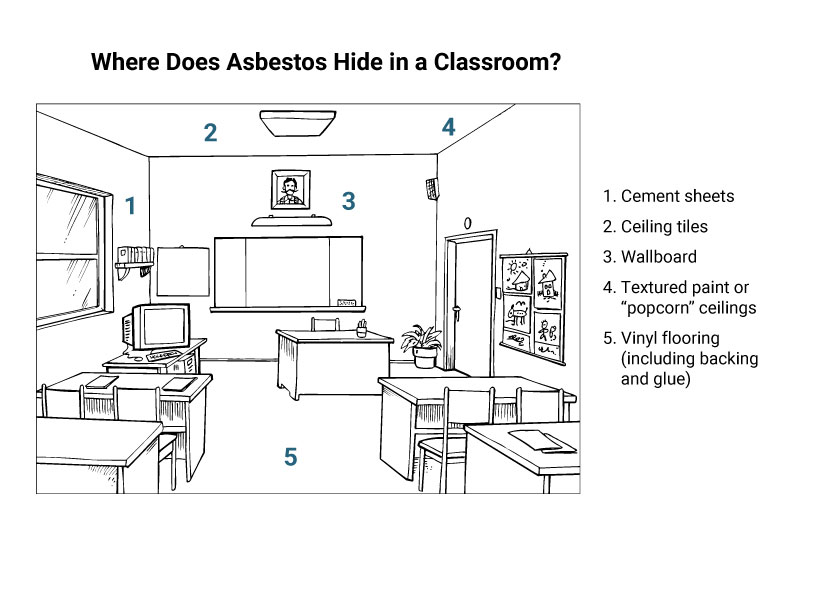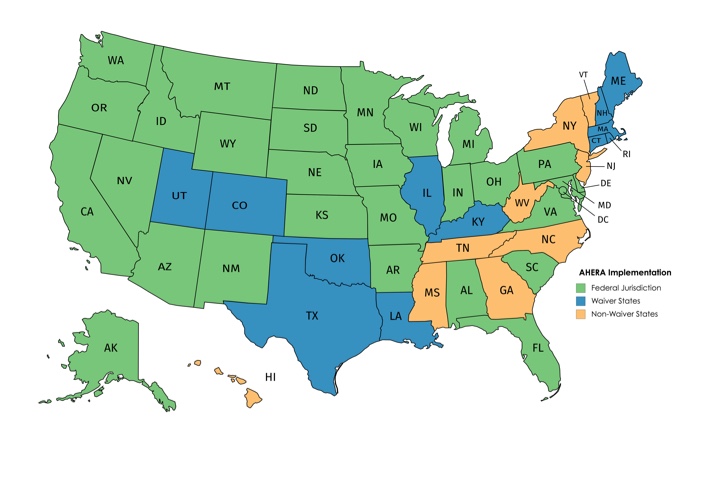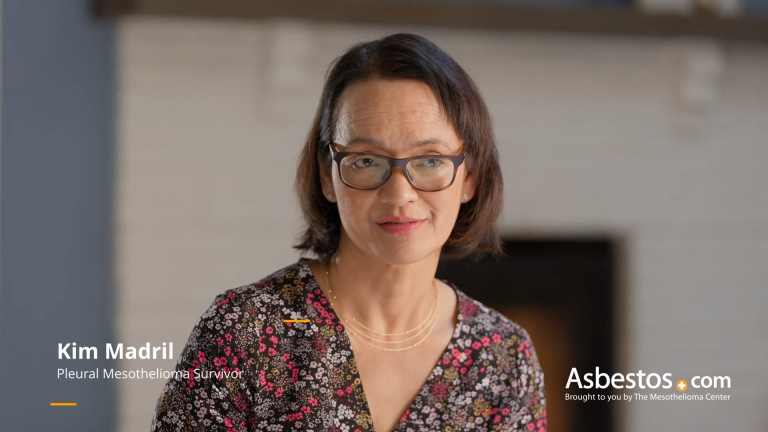Asbestos in Schools: A Guide for Parents & Administrators
Written by Michelle Whitmer | Edited by Amy Edel

Why Is Asbestos in Schools Dangerous?
Many older U.S. schools contain legacy asbestos in building materials. When these materials get damaged or wear down, tiny asbestos fibers float into the air. Students, teachers and staff who breathe in these fibers face serious health risks.
Asbestos is the primary cause of mesothelioma cancer. Inhaled asbestos fibers can also cause diseases such as asbestosis and lung cancer. Understanding asbestos exposure and the causes of mesothelioma helps clarify the long-term dangers these fibers pose.
Who Is Most at Risk From Asbestos in Schools?
Everyone who spends time in school buildings faces some level of risk from asbestos exposure. This includes students, teachers, custodians, bus drivers, coaches and office staff. Many may not realize older school buildings still contain asbestos. A 2024 study from the UK’s National Education Union states “any asbestos exposure carries some risk,” which matters most for people spending years or decades inside these buildings.
Patient Advocate Danielle DiPietro tells us, “I’ve worked with many teachers who developed mesothelioma. We’ve also helped maintenance workers exposed to asbestos while on the job.” This experience highlights how asbestos exposure can reach people in many roles within schools.
Long-term exposure to asbestos in these spaces increases the risk of serious diseases like mesothelioma. Schools need to manage asbestos carefully and keep everyone who spends time in these buildings informed and safe.
I went to a school with exposed asbestos in the gym every day. I hate to think about how many other kids this will happen to in schools today. Because it’s not at the forefront, no abatements are going on.
What Is the Current Status of Asbestos in Schools?
Many U.S. schools still have asbestos because removing it costs millions and disrupts learning. The Environmental Protection Agency currently requires schools to inspect for asbestos every 3 years and follow management plans under the Asbestos Hazard Emergency Response Act.
Schools remove asbestos only when it becomes damaged or poses a clear danger. Most schools keep asbestos materials in place and inspect them regularly to manage risks and keep students and staff safe.
Key Facts About Asbestos in U.S. Schools
- Most schools built before the 1980s contain asbestos materials
- Schools must inspect asbestos every 3 years and have management plans
- Removing asbestos can cost $15 to $25 or more per square foot
- A 2025 New York City audit found 82% of schools with asbestos missed required inspections
The New York City audit from the Office of the New York City Comptroller highlights a widespread struggle to meet asbestos rules in schools. Missing inspections puts students and staff at risk. The problem reflects national challenges in managing asbestos in older schools. Schools need better funding, training and oversight to protect health while managing costs and disruptions.

U.S. Schools With Asbestos
Many schools around the country have had asbestos problems recently, raising safety concerns. While not every case is urgent, this list of schools with asbestos shows how common asbestos in school buildings still is.
-
 Abingdon, VirginiaIn 2024, inspectors found asbestos in the floor tiles of Abingdon Elementary School in Abingdon, Virginia. They notified the school system about multiple violations, and the district took steps to fix the problem safely. Officials said students and staff were not exposed.
Abingdon, VirginiaIn 2024, inspectors found asbestos in the floor tiles of Abingdon Elementary School in Abingdon, Virginia. They notified the school system about multiple violations, and the district took steps to fix the problem safely. Officials said students and staff were not exposed. -
 Bowdoinham, MaineAn inspection in 2024 revealed asbestos risks at Bowdoinham Community School in Bowdoinham, Maine, along with others in the state. Inspectors flagged the school for aging building materials containing asbestos. School leaders worked quickly to address the issue.
Bowdoinham, MaineAn inspection in 2024 revealed asbestos risks at Bowdoinham Community School in Bowdoinham, Maine, along with others in the state. Inspectors flagged the school for aging building materials containing asbestos. School leaders worked quickly to address the issue. -
 Cape Coral, FloridaIn 2024, inspectors found asbestos in materials used during construction at Oasis Elementary in Cape Coral, Florida. The school district stopped work and followed safety protocols to protect students and staff. Officials said no exposure had occurred.
Cape Coral, FloridaIn 2024, inspectors found asbestos in materials used during construction at Oasis Elementary in Cape Coral, Florida. The school district stopped work and followed safety protocols to protect students and staff. Officials said no exposure had occurred. -
 Coggon, IowaA 2024 inspection found that the North Linn Community School District in Coggon, Iowa, failed to follow rules during asbestos work. Regulators fined the district after workers disturbed asbestos without proper safety measures. The district later cleaned up the area.
Coggon, IowaA 2024 inspection found that the North Linn Community School District in Coggon, Iowa, failed to follow rules during asbestos work. Regulators fined the district after workers disturbed asbestos without proper safety measures. The district later cleaned up the area. -
 New York CityIn 2025, a city audit found that inspectors had failed to properly examine 82% of NYC schools with known asbestos. The report raised concerns about oversight and the health of thousands of students. City officials promised a stronger follow-up.
New York CityIn 2025, a city audit found that inspectors had failed to properly examine 82% of NYC schools with known asbestos. The report raised concerns about oversight and the health of thousands of students. City officials promised a stronger follow-up. -
 North CarolinaA 2024 report identified several schools in North Carolina with asbestos concerns. Many of the buildings were older, and districts had not updated them. The state urged school officials to review their safety plans.
North CarolinaA 2024 report identified several schools in North Carolina with asbestos concerns. Many of the buildings were older, and districts had not updated them. The state urged school officials to review their safety plans. -
 OhioA 2024 national review of asbestos risks included schools across Ohio. Inspectors flagged older buildings for possible exposure dangers if not managed correctly. The state continues to work on improving inspections and awareness.
OhioA 2024 national review of asbestos risks included schools across Ohio. Inspectors flagged older buildings for possible exposure dangers if not managed correctly. The state continues to work on improving inspections and awareness. -
 Philadelphia, PennsylvaniaPhiladelphia schools have faced repeated asbestos problems in recent years. In 2023, officials closed at least one school due to damaged asbestos materials, prompting parents to raise concerns about cleanup delays. Health experts called for better oversight and faster action from the district.
Philadelphia, PennsylvaniaPhiladelphia schools have faced repeated asbestos problems in recent years. In 2023, officials closed at least one school due to damaged asbestos materials, prompting parents to raise concerns about cleanup delays. Health experts called for better oversight and faster action from the district.
Asbestos in Colleges and Universities
Colleges and universities have different rules than K–12 schools, regulated by the U.S. Environmental Protection Agency, the U.S. Occupational Safety and Health Administration and local agencies. They must inspect buildings, label asbestos risks, train workers and follow strict safety procedures.
Many college buildings were built before the 1980s, so asbestos is still a concern on many campuses. Some students have even raised concerns, like those at Columbia University.
Below is a list of schools with asbestos on the college level, where asbestos issues have made headlines in recent years.

-
 Fairmont State University – Fairmont, West VirginiaFairmont State University in Fairmont, West Virginia, has faced asbestos concerns after a lawsuit claimed unsafe conditions led to serious health issues. While the case is still unfolding, it has brought attention to the university’s aging infrastructure. School officials have said they follow all safety regulations.
Fairmont State University – Fairmont, West VirginiaFairmont State University in Fairmont, West Virginia, has faced asbestos concerns after a lawsuit claimed unsafe conditions led to serious health issues. While the case is still unfolding, it has brought attention to the university’s aging infrastructure. School officials have said they follow all safety regulations. -
 Langston University – Langston, OklahomaIn 2024, old campus buildings, including those with asbestos risks, frustrated students and staff at Langston University in Langston, Oklahoma. The school moved some classes online while addressing safety issues. The university said long-term repairs were part of a larger improvement plan.
Langston University – Langston, OklahomaIn 2024, old campus buildings, including those with asbestos risks, frustrated students and staff at Langston University in Langston, Oklahoma. The school moved some classes online while addressing safety issues. The university said long-term repairs were part of a larger improvement plan. -
 Northeastern University – Boston, MassachusettsFaculty at Northeastern University in Boston raised concerns in 2024 after learning that asbestos was likely present in older buildings. The university confirmed that it treats many spaces as if asbestos is present to protect safety. Some professors have asked for more transparency and testing.
Northeastern University – Boston, MassachusettsFaculty at Northeastern University in Boston raised concerns in 2024 after learning that asbestos was likely present in older buildings. The university confirmed that it treats many spaces as if asbestos is present to protect safety. Some professors have asked for more transparency and testing. -
 Sacramento State University – Sacramento, CaliforniaIn early 2025, students at Sacramento State University asked questions about campus safety after inspectors found asbestos in several older buildings. The school said it followed proper cleanup steps and posted warning signs as needed. Officials also promised to review their inspection process.
Sacramento State University – Sacramento, CaliforniaIn early 2025, students at Sacramento State University asked questions about campus safety after inspectors found asbestos in several older buildings. The school said it followed proper cleanup steps and posted warning signs as needed. Officials also promised to review their inspection process.

Latest Asbestos Lawsuits Over Exposure at Schools and Universities
People affected by asbestos exposure at schools sometimes file lawsuits claiming the school failed to manage or warn about asbestos hazards. These illnesses can take decades to appear, so lawsuits are often filed years later.
Recent Lawsuits Over Asbestos in School Buildings:
- Burlington Township School District (New Jersey): In 2025, Rachel Tyler, a teacher at Bernice Young Elementary, sued the district after doctors diagnosed her with cancer linked to asbestos exposure..
- Fairmont State University (West Virginia): In 2024, Donna Spurling sued the university for asbestos exposure she says led to mesothelioma. She attended the school from 1998 to 2004.
- Frankford High School (Philadelphia, Pennsylvania): Juan Namnun, a former P.E. teacher, filed a lawsuit in 2024 after doctors diagnosed him with a rare breast cancer. He blames long-term asbestos exposure at the school.
- Philadelphia Board of Education (Pennsylvania): In 2020, teacher Lea DiRusso received an $850,000 settlement after doctors diagnosed her with mesothelioma caused by years of exposure at two contaminated schools.
- Reed Elementary (Richmond, California): In 2025, families and staff pushed for the school’s rebuilding after asbestos and other hazards were left unaddressed for years. Legal action and public pressure played a role.
These lawsuits show how important it is for schools to follow asbestos safety laws. They also show the emotional and financial toll asbestos-related illnesses can take on individuals and families.
Anyone affected by asbestos exposure at a school should speak with a lawyer who understands these types of cases.
How Did Asbestos Get in Schools?
Half of U.S. schools were built between 1950 and 1969, when asbestos was widely used because it was cheap, strong and fire-resistant. People didn’t know it was dangerous back then.
Manufacturers put asbestos in many parts of schools, like floors, ceilings, pipes and walls, to make materials last longer and resist heat. Today, these materials can be risky if they get damaged or disturbed during repairs or renovations.
Asbestos Products in School Buildings
- Boiler insulation
- Ceiling tiles
- Cement sheets
- Ductwork for heating and cooling systems
- Pipe wrap insulation
- Textured paint or “popcorn” ceilings
- Vinyl flooring (including backing and glue)
- Wallboard
If these materials stay in good shape, they usually aren’t dangerous. But when damaged, asbestos fibers can be released, which is why schools must inspect and monitor them.
Where Was Asbestos Used in Schools?
Before the 1980s, asbestos was present in products used in almost every part of school buildings: classrooms, cafeterias, hallways, auditoriums and teachers’ lounges. High-traffic areas often had asbestos in ceiling tiles, floors and pipes.
In colleges, asbestos was also common in older dorms, especially floor tiles, heating systems and insulation. Science labs are a special concern because asbestos was used around sinks, fume hoods, pipes and even tabletops due to heat resistance needs.

What Has Been Done About Asbestos in School Buildings?
In 1986, Congress passed the Asbestos Hazard Emergency Response Act to protect students and staff. It requires K–12 schools to inspect for asbestos every three years, create a management plan and have a trained person in charge of asbestos safety.
AHERA doesn’t always require removal if asbestos is in good shape and not likely to be disturbed. Schools must repair or seal damaged asbestos to keep fibers from getting into the air. Some schools follow these rules well, but others struggle because of a lack of money or staff.
Removing asbestos is expensive and must be done carefully by licensed professionals because improper removal can release more fibers. That’s why AHERA focuses on safe monitoring and repair first.

What Happens When Asbestos Is Found in Schools?
Schools must follow AHERA rules to manage or remove asbestos safely. Even if asbestos is found, it doesn’t always have to be removed immediately if it’s in good condition and is monitored closely. This is called “management in place.”
Action Plans for Asbestos in Schools
Below are the most common options schools may follow once asbestos is found:
- Maintenance: Monitor asbestos materials and check for damage regularly.
- Repair: Fix small damaged areas safely to prevent fiber release.
- Encapsulation: Spray a sealant over asbestos materials to lock in fibers.
Enclosure: Build a barrier around asbestos material to keep it sealed off. - Removal: This is the only permanent fix. It’s expensive, risky and performed by licensed professionals.
Schools should have a plan and designate a responsible person for asbestos oversight. This helps families and staff understand what actions the school is taking.

Talking to Your Student’s School About Asbestos
Many parents worry about their children being exposed to asbestos in school buildings. You can get involved by asking questions and staying informed.
Even though federal law doesn’t always require schools to remove asbestos, families and staff can still help ensure the school monitors and manages it properly.
Tips for Parent and Community Involvement
- Attend school board meetings and ask about the school’s asbestos management plan.
- Reach out to your PTA or parent group to raise awareness and share resources.
- Contact your local or state government to learn about inspection policies and funding.
- For universities, get in touch with alumni organizations and student networks.
- Ask for a copy of the school’s asbestos plan. It should be public.
Working together, parents, staff and community members can help hold schools accountable or support them in getting the help they need.
Resources for Parents & Teachers
Understanding why school officials would spend money to remove asbestos from school buildings is key to supporting safer learning environments. Asbestos exposure can lead to severe health conditions, and schools have both a legal and ethical responsibility to protect students and staff.
Below are helpful tools and guides on asbestos safety, school inspection rules and how you can take action. These are especially useful if you want to know what schools are required to do and how to participate in keeping your community safe.
Here are some helpful Asbestos Resources for Families and Staff:
- Asbestos in Schools Fact Sheet (EPA)
- Healthy Indoor Air Quality in Schools (EPA)
- AHERA Asbestos Management Plan Checklist (EPA)
- Asbestos Management Plan Template (EPA)
- Asbestos Removal Costs (HomeAdvisor.com)
- Directory of Public School Districts (National Center for Education Statistics)
- State Contacts and Information (U.S. Department of Education)
- Asbestos Abatement Guide (The Mesothelioma Center at Asbestos.com)
These resources can help you better understand what’s happening in your school and what actions you can take. If you’re unsure where to begin, start by reviewing your school’s asbestos management plan or speaking with the designated asbestos contact.
Being informed is the first step to protecting your family, your coworkers and your community. Whether you’re a teacher, staff member, parent or student, your voice can help drive change.

Common Questions About Asbestos in Schools
- How do I find out if my child’s school has asbestos in it?
-
Start by calling your school’s main office and asking for a copy of the asbestos management plan. This plan should show the results of past inspections, whether asbestos was found and how it’s being managed. It will also list a contact person responsible for asbestos-related concerns. If the school doesn’t have the information, the district office should be able to help.
- Is it dangerous to have asbestos-containing materials in my school?
-
Not always. Asbestos is mainly dangerous when it’s damaged or disturbed, which can release harmful fibers into the air. According to the EPA, as long as asbestos materials are in good condition and properly maintained, they pose “relatively little risk to students and school employees.”
However, inspections should identify and evaluate these materials to prevent disturbing the products during renovations or demolitions.
- What should I do if I’m sick from asbestos in schools?
-
If you believe you’ve been exposed to asbestos at a school and now have symptoms, or if you’ve been diagnosed with mesothelioma or asbestos-related lung cancer, it’s important to speak with a medical specialist right away. Our Patient Advocates can help connect you with doctors who specialize in asbestos-related illnesses and explain your options for support and care.
- What are your rights if you’re exposed to asbestos in school?
-
If you were exposed to asbestos at a school and later developed an illness like mesothelioma or asbestos-related lung cancer, you may have the right to pursue legal action. This can include seeking compensation for medical expenses, lost wages or other damages. Talking to an attorney who handles asbestos cases can help you understand your rights and next steps.








